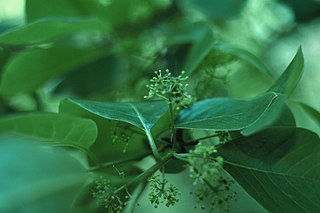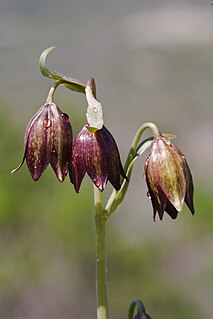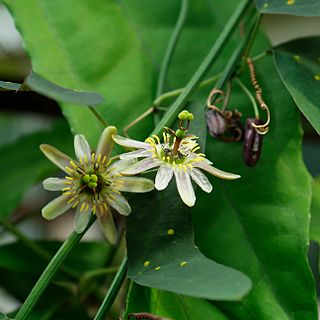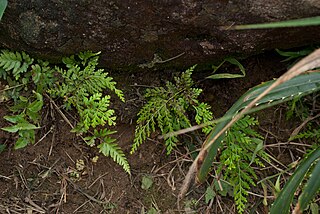
Tupelo, genus Nyssa, is a small genus of deciduous trees with alternate, simple leaves. It is sometimes included in the subfamily Nyssoideae of the dogwood family, Cornaceae, but is placed by other authorities in the family Nyssaceae. In the APG IV system, it is placed in Nyssaceae.

Abelia is a formerly recognized genus that contained about 30 species and hybrids, placed in the honeysuckle family, Caprifoliaceae. Molecular phylogenetic studies showed that the genus was not monophyletic, and in 2013, Maarten Christenhusz proposed the merger of Abelia into Linnaea, along with some other genera. Abelia section Zabelia was raised to the genus Zabelia.

Viola biflora is a species of the genus Viola. It is also called alpine yellow-violet, arctic yellow violet, or twoflower violet. It is found in Europe, Siberia, Central Asia, Pakistan, western and northern China, North Korea, Japan, and Western North America.

Collomia is a genus of flowering plants in the family Polemoniaceae. Species in the genus are known generally as trumpets, mountain trumpets, or trumpet flowers. They are native to North America and southern South America. The genus name comes from the Greek kolla ("glue"), a reference to the seeds, which become gelatinous in texture when wet.

Lycianthes is a genus of plants from the nightshade family (Solanaceae), found in both the Old World and the New World, but predominantly in the latter. It contains roughly 150 species, mostly from tropical America, with 35-40 species in Asia and the Pacific.

Fritillaria biflora is a species of fritillary native to western California and northern Baja California. It occurs in the chaparral and woodlands ecoregion, often in serpentine soil formations and hillside grassland habitats.

Aechmea biflora is a species of plant in the family Bromeliaceae. It is endemic to Ecuador. Its natural habitat is subtropical or tropical moist montane forests. The species name means "2-flowered," referring to two flowers in each fascicle.

Faramea is a genus of plant in the family Rubiaceae.
Bewsia is a genus of African plants in the grass family. The only known species is Bewsia biflora, widespread across much of sub-Saharan Africa from Ivory Coast to Tanzania to KwaZulu-Natal.

Passiflora biflora, the twoflowered passionflower, is a vine with paired peduncles and flowers up to 3.5 cm (1.4 in) wide. It is native to the New World from Mexico to Colombia and Venezuela. In Florida, P. biflora has been classified by the Exotic Pest Plant Council as a non-native species that has the "potential to disrupt native plant communities."

Hedyotis (starviolet) is a genus of flowering plants in the family Rubiaceae. Many species of this genus such as Hedyotis biflora, H. corymbosa and H. diffusa are well known medicinal plants. Hedyotis is native to tropical and subtropical Asia and to islands of the northwest Pacific. It comprises about 115 species. The type species for the genus is Hedyotis fruticosa.

Krigia biflora, also known as two-flower cynthia or two-flower dwarf dandelion, is a species of plant in the sunflower family. It is native to North America, where it is found in central Canada and in the eastern, central, and southwestern United States. This species is rare in Connecticut, and it is listed as a species of special concern.

Stylosanthes biflora, known by the common name sidebeak pencilflower, is a species of flowering plant in the legume family. It is native to the Southeastern United States where it is widespread in open areas of native vegetation. It producers yellow-orange flowers in the summer and fall.

Milla biflora, Mexican star, is a species of flowering plant native to Arizona, New Mexico, Texas, Mexico, Honduras and Guatemala, where it grows at 1,000–2,700 m (3,300–8,900 ft) elevation. It is perennial, growing from a 1–2 cm (0.4–0.8 in) corm, and flowering in summer. Inflorescences of 1–9 white flowers are borne on scapes 4–55 cm (1.6–21.7 in) long. The 2–10 leaves are each 1 mm (0.04 in) wide and half to equally as long as the scape. The fruits are ovoid capsules, 1.5–2 cm (0.6–0.8 in) long.
Scleria biflora is a plant in the family Cyperaceae. It grows as a tufted annual grass.

Melanthera biflora, also known as sea daisy, beach daisy and sea ox-eye,, is a species of flowering plant in the aster family. It is a scandent, rough-looking and fast-growing plant with a wide distribution.

Darwinia biflora is a plant in the myrtle family Myrtaceae and is endemic to New South Wales. It is an erect, often straggly shrub with flattened, glabrous leaves, and flowers which are arranged in pairs. The flowers are greenish in colour but each is surrounded by two purple-red bracteoles and have a long yellow-green style projecting out of the flower tube. The species only occurs in the Sydney region in a few places where shale-capped ridges intergrade with Hawkesbury sandstone.

Tubho tea, is a traditional herbal tea of the Ivatan people in the Philippines made from dried leaves of the tubho fern.

Odontosoria biflora is a species of fern in the family Lindsaeaceae. As with other species in the family, it has been placed in different genera; synonyms include Sphenomeris biflora and Sphenomeris chinensis ssp. biflora. It is native to Southeast China, Korea, Japan and its offshore islands, Taiwan, and the Philippines. The fronds are leathery in texture, with the final segments being wedge-shaped. In the northern Philippines, it is described as "common", being found on ridges and rocks at elevations of up to about 150 m.

Tulipa biflora, the two-flowered tulip, is a species of tulip native to the former Yugoslavia, Crimea, Anatolia, the Caucasus, southern Russia, Egypt, the Middle East, Central Asia, Iran, Pakistan, Afghanistan and Xinjiang in China. Cultivated, it has two, occasionally one or three, flowers borne on a single stalk.
















